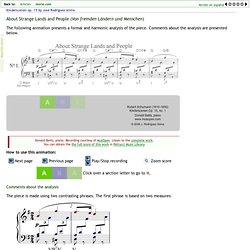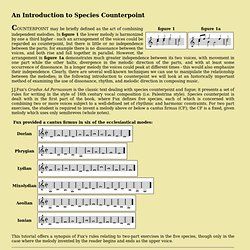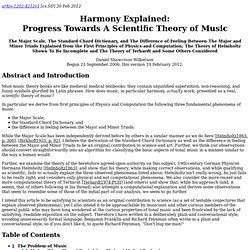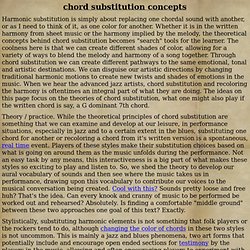M THEORY
> Elpana
> MUSIC
Key Chords. Key Chords app generates guitar chord progressions automatically.

Use it free online, or get the app for Mac, Windows or iOS (iPad)
A Capella Jazz Vocal Arrangement Lesson. StumbleUpon. StumbleUpon. StumbleUpon. StumbleUpon. Www.hooktheory. 4-bass. Figured Harmony Exercises. Songs with the same chords - TheoryTab. Key: To begin, click a circle to the left.

The default key is C and the options are the six most common chords used in this key. Search the Theory Tab library by chord progression to find: the most popular chord progressions in music, songs that have the same chords, and the most likely chords to follow any progression. Please rotate your device. I work best in widescreen! This area will populate with songs containing the chord progression that you build.
Matching Piano Keys to Sheet Music. Hooktheory. Cont. 210 Awesome Open Guitar Chords and How to Use Them - A Kings Mercury. Are you bored of the sound of standard chords?

Then, using open guitar chords is a way to pimp up your playing and boring chord progressions. There are thousands of open guitar chords and millions of ways to use them creatively. In this post I introduce you to the world of open chords with a brief introduction, a library of 210 open guitar chords and some ideas on how to use them properly.
Open chords are chords that have at least one open string like this shape of E-minor x7x087. Within this definition standard chords like C-major x32010 are also open chords because of their open strings. Below you find five din-A4 pages full of guitar chords. 210 to be precise, I counted them.
Download Course Materials. Kinderszenen op. 15, no. 1. The following animation presents a formal and harmonic analysis of the piece.

Comments about the analysis are presented below. Comments about the analysis The piece is made using two contrasting phrases.
Chord To Scale Harmonizer (beta)
Electronic Music Theory: How to Quickly Write Better Chord Progressions w/ Pat Cupo. A lot of students have asked me for tips and tricks to writing better chord progressions.

By that time they had already learned about building Major and Minor chords, but when it came to a chord progression – a series of chords occurring in time – they were a bit stuck. If you’re ever in the same position, then feel free to use these simple guidelines to help you quickly write chord progressions. Follow them carefully and strictly at first and over time it’ll start to come naturally to you. 1) Use only Major or Minor chords. Just keep things simple. C Major. Jazz Modes Chart. Music Theory for Songwriters - Home.
Species Counterpoint. An Introduction to Species Counterpoint COUNTERPOINT may be briefly defined as the art of combining independent melodies.

In figure 1 the lower melody is harmonized by one a third higher - such an arrangement of the voices could be regarded as counterpoint, but there is little or no independence between the parts; for example there is no dissonance between the voices, and both rise and fall together in parallel. However, the arrangement in figure 1a demonstrates much greater independence between its two voices, with movement in one part while the other halts, divergence in the melodic direction of the parts, and with at least some occurrence of dissonance. In a longer melody the voices could peak at different times - this would also emphasize their independence. J.J.Fux's Gradus Ad Parnassum is the classic text dealing with species counterpoint and fugue; it presents a set of rules for writing in the style of 16th century vocal composition (i.e.
Music Theory For Songwriting Part 1 - Hooktheory. THE ETHOS OF THE AXIS SYSTEM. (tonal serialism) Comparisons are, by their very nature, delusive.

Still, I would like to venture the following comparative statement: classical harmony is to modal harmony what a geocentric world concept is to a heliocentric one.
Scale Theory Chart. The interactive circle of fifths. Free printable staff paper @ Blank Sheet Music .net. Measuring the Evolution of Contemporary Western Popular Music : Scientific Reports. To identify structural patterns of musical discourse we first need to build a ‘vocabulary’ of musical elements (Fig. 1).

To do so, we encode the dataset descriptions by a discretization of their values, yielding what we call music codewords20 (see Supplementary Information, SI). In the case of pitch, the descriptions of each song are additionally transposed to an equivalent main tonality, such that all of them are automatically considered within the same tonal context or key. Next, to quantify long-term variations of a vocabulary, we need to obtain samples of it at different periods of time.
For that we perform a Monte Carlo sampling in a moving window fashion.
MUSIC RESEARCH AND MUSIC THEORY. EMS: Technical Essays. Harmony Explained: Progress Towards A Scientific Theory of Music. The Major Scale, The Standard Chord Dictionary, and The Difference of Feeling Between The Major and Minor Triads Explained from the First Principles of Physics and Computation; The Theory of Helmholtz Shown To Be Incomplete and The Theory of Terhardt and Some Others Considered Daniel Shawcross Wilkerson Begun 23 September 2006; this version 19 February 2012.

Abstract and Introduction Most music theory books are like medieval medical textbooks: they contain unjustified superstition, non-reasoning, and funny symbols glorified by Latin phrases. How does music, in particular harmony, actually work, presented as a real, scientific theory of music?
Jazz chord substitution. Chord substitution concepts Harmonic substitution is simply about replacing one chordal sound with another, or as I need to think of it, as one color for another.

Whether it is in the written harmony from sheet music or the harmony implied by the melody, the theoretical concepts behind chord substitution becomes "search" tools for the learner. The coolness here is that we can create different shades of color, allowing for a variety of ways to blend the melody and harmony of a song together. Through chord substitution we can create different pathways to the same emotional, tonal and artistic destinations.
We can disguise our artistic directions by changing traditional harmonic motions to create new twists and shades of emotions in the music. Theory / practice. Stylistically, substituting harmonic elements is not something that folk players or the rockers tend to do, although changing the color of chords in these two styles is not uncommon. Chord type.
Marc Sabatella's Jazz Improvisation Primer: Chord/Scale Chart. Outline of basic music theory - www.oscarvandillen.com. Professional music theory: an outline of basic music theory. Preface and Chapter 1 of the Outline of basic music theory – by Oscar van Dillen ©2011-2014 The beginner’s learning book can be found at Basic elements of music theory. Overview of chapters: Chapter 1: Introduction Chapter 2: Sound and hearing Chapter 3: Musical notation Chapter 4: Basic building blocks of melody and harmony Chapter 5: Consonance and dissonance Chapter 6: Circle of fifths and transposition Chapter 7: Concerning rhythm, melody, harmony and form Chapter 8: Further study Preface.
Lessons from premiere instructors throughout the Keyboard Community - KeyboardMag.com. Classic piano method : how to play piano. Here I publish a complete classic piano method by Karl Merz. This book was published in 1885 but contains many useful exercises and tips to study and learn piano. Moreover it contains helpful tips and suggestions for piano teachers Piano method summery. Learning and Loving Music Theory. Kelvin, You actually caught a mistake on the roman numerals! Thanks, I’ll have to fix that. The first and last chords of the progression are not 7th chords. Somehow I inadvertently typed “I7″ on the first chord of all the major keys. (Notice that I didn’t do that for the minor keys.)
Harmonic Functions - Augmented Sixths. We will start by transforming the iv degree chord of the A minor key into an augmented sixth chord.
Below is the i - iv - V - i progression in A minor: now, we set the iv degree chord in first inversion: by raising the root of the iv degree chord a half-step (D# in this case) we get an augmented sixth chord: The chord receives the name of Augmented Sixth chord because of the augmented sixth interval between the bass and the chromatically raised note. By raising this note we increase the harmonic tension.
Pitch axis theory. Concept[edit]
Paradigms of Tonal Chord Progression. Jazz Progressions. Reharmonization simplified. Musical Scales. Free Music Theory Worksheets!
Material on this page is free.NEW! You can now consult an index of terms used in these worksheets.Also explore a page of worksheet extras: Worksheet Answers, Test Templates and Flash Presentations.
List of chord progressions.
How Music REALLY Works!, Chapter 6: How Chords and Chord Progressions REALLY Work. 6.17.1 Optimizing Unity and Variety in Chord Progressions 6.17.2 Emotional Effects of Chords The writer Tom Wolfe once advised that, just as a doctor learns, “First, do no harm,” so an artist must keep in mind, “First, entertain.” In songwriting, this applies to every aspect: harmony, rhythm, melody, form, lyrics, performance. “To entertain” means pretty much the same thing as, “Create sufficient variety.
Giant Steps, Central Park West, and Modulatory Cycles - John Coltrane's harmonic technique. Share Download as printable PDF file Along with his intellectual and creative gifts, John Coltrane obviously had a knack for finding just the right titles for his compositions. Giant Steps and Central Park West both employ modulatory ‘cycles’ — but they do so quite differently. His Giant Steps are the bold, breath-snatching modulations by which he audaciously displays the song’s underlying conceptual structure.
The GSA Music Theory Department. Chord Families. Marc Sabatella's Jazz Improvisation Primer: Major Scale Harmony. Determining chord progressions in a song. Guitar Theory Resources Chord Scales. G DIM(O) Guitar Chord Fingering. Ricci Adams' Musictheory.net.










